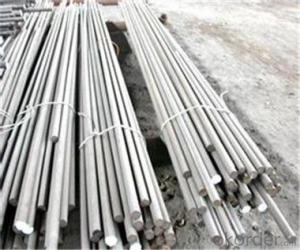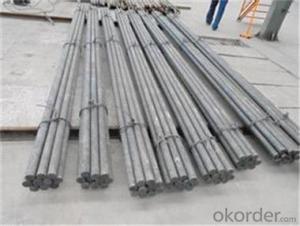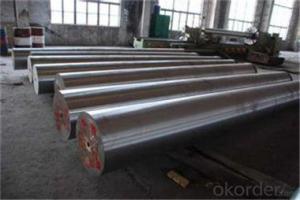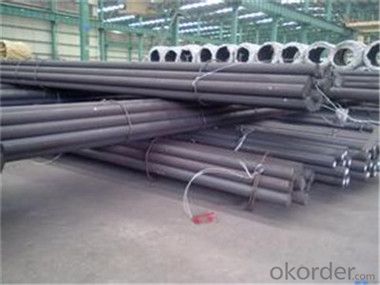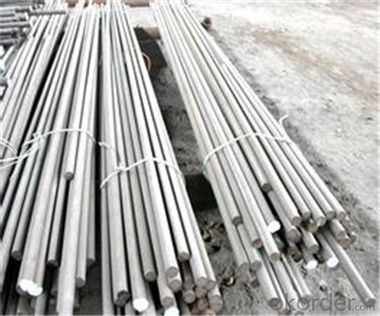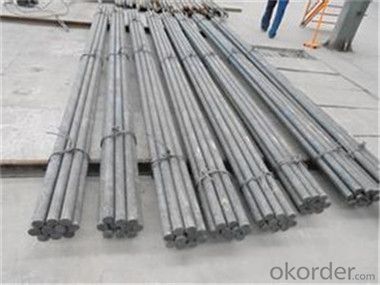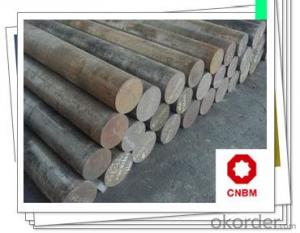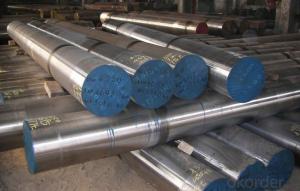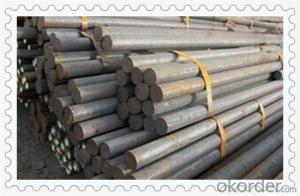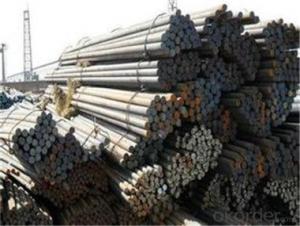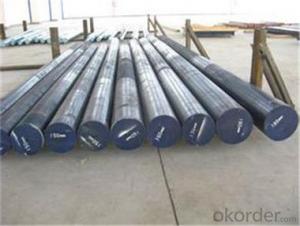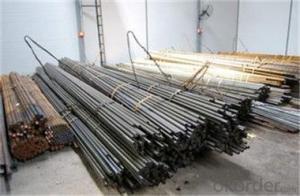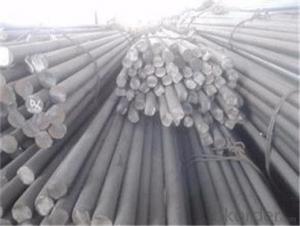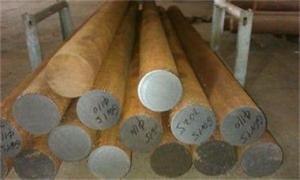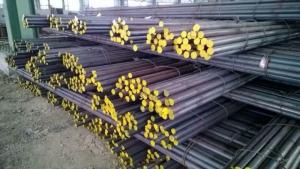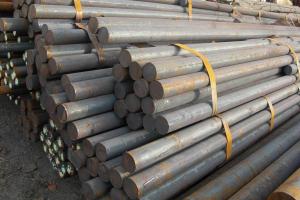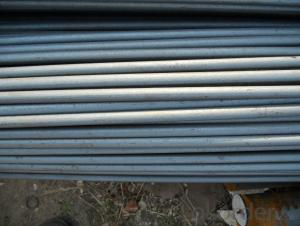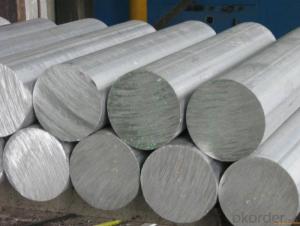Hard Chrome Carbon Steel Round Bar with Good Quality CNBM
- Loading Port:
- Tianjin
- Payment Terms:
- TT OR LC
- Min Order Qty:
- 990 m.t.
- Supply Capability:
- 2000000 m.t./month
OKorder Service Pledge
OKorder Financial Service
You Might Also Like
Description of steel round bar:
1.Diameter 80 to 800 mm
2.Black or Bright surface
3.Annealed or Quenched and tempered provided
4.Cutting service provide
Festures of steel round bar:
4340 Forged Round Steel Bar
1.Dia 80-800mm Length:2000-13000mm or as required
2.Technique:Forged
3.Delivery Time:45 days
Specifications of steel round bar:
Description |
Carbon Steel Rod/Carbon Steel Bar,carbon steel rod,carbon steel shaft,mild steel bar, mild steel shaft,ms bar | |
Material | ASTM | 1005,1006,1008,1010,1015,1020,1025,1030,1035,1040,1045,1050,1055,1060,1065,1070,1080,1084, 1016,1022 |
DIN | Ck10,Ck15,Ck22,Ck25,Ck30,Ck35,Ck40,Ck45,Ck50, 30Mn4,40Mn4 | |
BS | 040A04,095M15,045M10,080A40,045M10,080M50 | |
Standard | GB/T799,ASTM A29,A108,A321,A575,BS970,DIN1652,JIS G4051 | |
Section shape |
Round | |
Length |
As your required | |
Application | Carbon steel rod applies to chemical industry, shipping industry, manufacturing industry,construction,decorate Industry,electric power, pump shafts, sanitary wares,furniture handles,boiler,high temperature resistant,low temperature resistant, corrosion resistant. | |
Images of steel round bar:
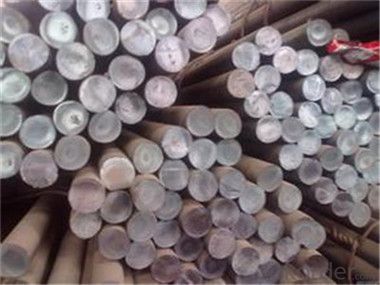
FAQ:
1. What is your package?
Packing situation: standard seaworthy packing or as customer required.
2. How long is the lead time?
Delivery time: 45 days after order confirmed.
3. What payment term do you accept?
Payment: T/T or L/C at sight.
- Q: What are the different grades of alloy steel round bars for automotive applications?
- There are several different grades of alloy steel round bars used for automotive applications, including 4140, 4340, and 8620. These grades offer varying levels of strength, toughness, and wear resistance, allowing them to be used in different automotive components such as shafts, gears, and axles. The choice of grade depends on the specific requirements of the application, taking into consideration factors like load capacity, durability, and cost.
- Q: What are the typical tolerances for steel round bars?
- The typical tolerances for steel round bars can vary depending on the specific grade and size of the bar. However, common industry standards typically specify tolerances in terms of diameter deviation, straightness, and length. For diameter, tolerances can range from +/- 0.005 to +/- 0.25 inches, again depending on the bar size. Straightness tolerances are often specified as a maximum deviation per foot or meter, such as 0.010 inches per foot. Length tolerances can range from +/- 0.125 to +/- 1 inch. It's important to consult the appropriate industry standards or supplier specifications for precise tolerances based on the specific requirements of the project or application.
- Q: What are the different types of steel round bar heat treatments?
- Steel round bars can undergo several types of heat treatments, each aiming to enhance specific material properties. Common heat treatments include annealing, normalizing, quenching and tempering, and case hardening. 1. Annealing involves heating the steel round bar to a high temperature and gradually cooling it to room temperature. This process relieves internal stresses, improves machinability, and enhances ductility and toughness. 2. Normalizing, similar to annealing, requires heating the steel round bar to a specific temperature. However, instead of slow cooling, the bar is left to cool in air. Normalizing refines the grain structure, improves mechanical properties, and enhances machinability. 3. Quenching and tempering entails heating the steel round bar to a high temperature and rapidly cooling it using a quenching medium like oil or water. This rapid cooling achieves high hardness and strength. Subsequently, the steel is tempered by reheating it to a lower temperature, enhancing toughness and reducing brittleness. 4. Case hardening is employed to increase the surface hardness of the steel round bar while maintaining a tough core. This treatment involves heating the bar in the presence of carbon-rich substances like gas or liquid carburizing agents. It results in a hardened outer layer, known as the case, while the core remains relatively softer and more ductile. These examples demonstrate the various heat treatments applicable to steel round bars. The choice of heat treatment depends on the desired properties and applications of the steel. Consulting with metallurgical experts ensures the selection of the most appropriate treatment for each specific steel round bar.
- Q: Can steel round bars be used for gear applications?
- Yes, steel round bars can be used for gear applications. Steel round bars are often used in the manufacturing of gears due to their high strength and durability. They provide excellent mechanical properties, such as hardness and wear resistance, which are essential for gear applications. Steel round bars can be machined and heat-treated to achieve the desired tooth profile and surface finish required for gears. Additionally, steel round bars offer good dimensional stability and can withstand high loads and torque, making them suitable for various gear applications in industries such as automotive, machinery, and heavy equipment.
- Q: What are the typical tolerances for steel round bars?
- The typical tolerances for steel round bars can vary depending on the specific grade and size of the bar. However, common industry standards typically specify tolerances in terms of diameter deviation, straightness, and length. For diameter, tolerances can range from +/- 0.005 to +/- 0.25 inches, again depending on the bar size. Straightness tolerances are often specified as a maximum deviation per foot or meter, such as 0.010 inches per foot. Length tolerances can range from +/- 0.125 to +/- 1 inch. It's important to consult the appropriate industry standards or supplier specifications for precise tolerances based on the specific requirements of the project or application.
- Q: Can steel round bars be used in the manufacturing of hydraulic components?
- Yes, steel round bars can be used in the manufacturing of hydraulic components. Steel is a common material used in the construction of hydraulic components due to its strength, durability, and resistance to corrosion. Steel round bars can be shaped and machined to create various hydraulic components such as pistons, cylinders, valves, and fittings. The use of steel round bars ensures that these components can withstand high pressures and continue to function effectively in various hydraulic systems.
- Q: What is the maximum vanadium content allowed for steel round bars?
- The maximum vanadium content allowed for steel round bars varies depending on the specific steel grade and industry standards. Vanadium is commonly used as an alloying element in steel to improve its strength, hardness, and resistance to corrosion. In general, the maximum vanadium content in steel round bars ranges from 0.02% to 0.25%. However, it is important to note that different steel grades and applications may have specific limits set by industry regulations or customer requirements. Therefore, it is crucial to consult the relevant standards and specifications for the specific steel grade and application to determine the maximum allowed vanadium content for steel round bars.
- Q: What is the difference between a cold finished and a turned steel round bar?
- Cold finished steel round bars and turned steel round bars are utilized in various industries for different purposes. The manufacturing process and resulting properties distinguish these two types of steel bars. For a cold finished steel round bar, the production involves cold drawing or cold rolling a hot rolled steel bar. This entails passing the hot rolled bar through a series of dies at room temperature, which decreases its diameter and increases its length. Through the cold drawing process, the steel acquires specific mechanical properties, including enhanced surface finish, dimensional accuracy, and increased strength. Cold finished steel bars possess a sleek, glossy surface and are renowned for their precise tolerances and consistent size and shape. They find common usage in applications requiring precision and high-quality surface finish, such as the automotive, aerospace, and machining industries. Conversely, a turned steel round bar is created by machining a hot rolled or cold finished bar on a lathe. The bar is secured and rotated while a cutting tool eliminates material from its outer surface, resulting in the desired shape and dimensions. This turning process yields a bar with a rougher surface compared to a cold finished bar. However, it enables faster production and versatility in creating diverse shapes and sizes. Turned steel bars are frequently employed in applications where the surface finish is not crucial but machining operations are necessary, such as in the construction, engineering, and manufacturing industries. In conclusion, the distinction between a cold finished and a turned steel round bar lies in the manufacturing process and the resulting properties. Cold finished bars are produced through cold drawing or cold rolling, leading to improved dimensional accuracy, surface finish, and strength. Turned bars are machined on a lathe, providing flexibility in shape and size but with a rougher surface finish. The choice between the two depends on the specific requirements of the application, including tolerance, surface finish, strength, and machinability.
- Q: What are the advantages of using heat-treatable steel round bars?
- Using heat-treatable steel round bars offers several advantages: 1. Strength Enhancement: Controlled heating and cooling processes can be applied to heat-treatable steel round bars, which enhance their strength and hardness. This renders them suitable for applications demanding high strength and durability. 2. Enhanced Resistance to Wear: Heat treatment enables the development of a hardened surface layer on the steel round bars, significantly improving their wear and abrasion resistance. As a result, they are ideal for use in industries such as manufacturing, construction, and automotive, where components experience heavy wear and tear. 3. Tailored Customization: Heat-treatable steel round bars possess the advantage of easy customization to meet specific requirements. By adjusting the heat treatment process, the bars' hardness, strength, and other mechanical properties can be tailored to suit different applications, ensuring optimal performance. 4. Convenient Machinability: Heat-treatable steel round bars generally exhibit good machinability, allowing for easy cutting, drilling, or shaping into various forms without compromising their structural integrity. This convenience reduces production time and costs. 5. Versatility: Heat-treatable steel round bars find versatile applications across a wide range of industries, including construction, manufacturing, oil and gas, automotive, and aerospace. They are commonly utilized in the production of shafts, gears, bolts, axles, and other critical components. 6. Long-term Cost-effectiveness: Although heat-treatable steel round bars may initially have a higher cost compared to non-heat-treatable or lower-grade steels, their durability and enhanced properties make them cost-effective in the long run. The improved strength and wear resistance contribute to a longer service life, reducing the need for frequent replacements and maintenance. In conclusion, the utilization of heat-treatable steel round bars offers a multitude of benefits, including increased strength, improved wear resistance, customized properties, easy machinability, versatility, and long-term cost-effectiveness. These advantages position them as the preferred choice for demanding applications requiring high-performance materials.
- Q: What are the different marking methods for steel round bars?
- There are several marking methods commonly used for steel round bars. These methods are used to identify and provide information about the steel bars, such as their specifications, grades, manufacturer, and other relevant details. 1. Stamping: Stamping is a widely used marking method in which information is imprinted onto the surface of the steel round bar using a stamping machine. This can include alphanumeric characters, symbols, or logos. Stamping provides a permanent and durable marking that is resistant to wear and corrosion. 2. Laser Marking: Laser marking is a precise and high-quality marking method that uses a laser beam to engrave information onto the surface of the steel round bar. This method allows for intricate designs, barcodes, and serial numbers to be marked. Laser marking provides permanent identification that is resistant to fading and tampering. 3. Inkjet Printing: Inkjet printing is a non-contact marking method that uses inkjet technology to print information onto the steel round bar's surface. This method is commonly used for marking barcodes, QR codes, and other data matrix codes. Inkjet printing allows for fast and efficient marking, and the ink used is designed to adhere to the steel surface effectively. 4. Etching: Etching is a chemical marking method that involves using acid or other chemicals to remove layers of the steel round bar's surface, creating a visible mark. This method is commonly used for marking logos, identification numbers, or other designs. Etching provides a permanent marking that can be easily read and is resistant to wear. 5. Color Coding: Color coding is a simple marking method that involves using paint or colored coatings to mark different types or grades of steel round bars. Each color represents a specific attribute or characteristic, such as strength, corrosion resistance, or heat resistance. Color coding provides quick and visual identification of the steel round bars. These marking methods play a crucial role in ensuring proper identification, traceability, and quality control of steel round bars in various industries such as construction, manufacturing, and engineering. The choice of marking method depends on factors such as the required level of permanence, visibility, and the specific information to be marked on the steel round bars.
Send your message to us
Hard Chrome Carbon Steel Round Bar with Good Quality CNBM
- Loading Port:
- Tianjin
- Payment Terms:
- TT OR LC
- Min Order Qty:
- 990 m.t.
- Supply Capability:
- 2000000 m.t./month
OKorder Service Pledge
OKorder Financial Service
Similar products
Hot products
Hot Searches
Related keywords

